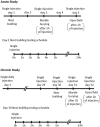Attenuation of Compulsive-Like Behavior Through Positive Allosteric Modulation of α4β2 Nicotinic Acetylcholine Receptors in Non-Induced Compulsive-Like Mice
- PMID: 28105008
- PMCID: PMC5214813
- DOI: 10.3389/fnbeh.2016.00244
Attenuation of Compulsive-Like Behavior Through Positive Allosteric Modulation of α4β2 Nicotinic Acetylcholine Receptors in Non-Induced Compulsive-Like Mice
Abstract
Nicotinic α4β2 receptors are the most abundant subtypes of nicotinic acetylcholine receptors (nAChRs) expressed in brain regions implicated in obsessive compulsive disorder (OCD). These receptors are known to modify normal and addictive behaviors by modulating neuronal excitability. Desformylflustrabromine (dFBr) is a novel, positive allosteric modulator (PAM) of high acetylcholine sensitivity (HS) and low acetylcholine sensitivity (LS) α4β2 nAChRs. The present study tested the hypothesis that positive allosteric modulation of α4β2 receptors by dFBr will attenuate compulsive-like behavior in a non-induced compulsive-like mouse model. Male mice (Mus musculus) selected for compulsive-like nesting behavior (NB; 48 animals; 12 per group) received acute (once) and chronic (every day for 32 days) subcutaneous injection of dFBr at 2, 4 and 6 mg/kg doses. Saline was used as a control (0 mg/kg). Compulsive-like NB was assessed after 1, 2, 3, 4, 5 and 24 h, while compulsive-like marble burying (MB) and anxiety-like open field (OF) behaviors were performed 2 h after dFBr administration. In the acute administration protocol, dFBr dose dependently attenuated NB and MB. Rapid effects (1-2 h after drug administration) of dFBr on MB and NB were observed for the chronic administration which was in congruence with the acute study. Chronic administration also revealed sustained suppression of NB by dFBr following 5 weeks of treatment. In both the acute and chronic regimen dFBr did not modulate OF behaviors. This research demonstrates the novel role of positive allosteric modulation of α4β2 nicotinic receptors by dFBr as a translational potential for OCD.
Keywords: desformylflustrabromine (dFBr); non-induced compulsive-like mice; obsessive compulsive disorder; positive allosteric modulator; α4β2 nicotinic receptors.
Figures





Similar articles
-
Allosteric modulation of α4β2* nicotinic acetylcholine receptors: Desformylflustrabromine potentiates antiallodynic response of nicotine in a mouse model of neuropathic pain.Eur J Pain. 2018 Jan;22(1):84-93. doi: 10.1002/ejp.1092. Epub 2017 Aug 14. Eur J Pain. 2018. PMID: 28809075 Free PMC article.
-
Positive allosteric modulation of α4β2 nicotinic acetylcholine receptors as a new approach to smoking reduction: evidence from a rat model of nicotine self-administration.Psychopharmacology (Berl). 2013 Nov;230(2):203-13. doi: 10.1007/s00213-013-3145-2. Epub 2013 May 28. Psychopharmacology (Berl). 2013. PMID: 23712602 Free PMC article.
-
Pharmacological characterization of the allosteric modulator desformylflustrabromine and its interaction with alpha4beta2 neuronal nicotinic acetylcholine receptor orthosteric ligands.J Pharmacol Exp Ther. 2010 Sep 1;334(3):917-26. doi: 10.1124/jpet.110.167684. Epub 2010 Jun 1. J Pharmacol Exp Ther. 2010. PMID: 20516140 Free PMC article.
-
Desformylflustrabromine: A Novel Positive Allosteric Modulator for beta2 Subunit Containing Nicotinic Receptor Sub-Types.Curr Pharm Des. 2016;22(14):2057-63. doi: 10.2174/1381612822666160127113159. Curr Pharm Des. 2016. PMID: 26818864 Review.
-
α4β2* neuronal nicotinic receptor ligands (agonist, partial agonist and positive allosteric modulators) as therapeutic prospects for pain.Eur J Pharmacol. 2013 Jul 15;712(1-3):22-9. doi: 10.1016/j.ejphar.2013.04.021. Epub 2013 May 7. Eur J Pharmacol. 2013. PMID: 23660369 Review.
Cited by
-
Acetylcholine Neurons Become Cholinergic during Three Time Windows in the Developing Mouse Brain.eNeuro. 2024 Jul 16;11(7):ENEURO.0542-23.2024. doi: 10.1523/ENEURO.0542-23.2024. Print 2024 Jul. eNeuro. 2024. PMID: 38942474 Free PMC article.
-
Melanin concentrating hormone modulates oxytocin-mediated marble burying.Neuropharmacology. 2018 Jan;128:22-32. doi: 10.1016/j.neuropharm.2017.09.008. Epub 2017 Sep 6. Neuropharmacology. 2018. PMID: 28888943 Free PMC article.
-
Acute Administration of Desformylflustrabromine Relieves Chemically Induced Pain in CD-1 Mice.Molecules. 2019 Mar 7;24(5):944. doi: 10.3390/molecules24050944. Molecules. 2019. PMID: 30866543 Free PMC article.
-
Desformylflustrabromine, a positive allosteric modulator of α4β2-containing nicotinic acetylcholine receptors, enhances cognition in rats.Pharmacol Rep. 2020 Jun;72(3):589-599. doi: 10.1007/s43440-020-00092-4. Epub 2020 Mar 23. Pharmacol Rep. 2020. PMID: 32207091 Free PMC article.
-
Allosteric modulation of α4β2* nicotinic acetylcholine receptors: Desformylflustrabromine potentiates antiallodynic response of nicotine in a mouse model of neuropathic pain.Eur J Pain. 2018 Jan;22(1):84-93. doi: 10.1002/ejp.1092. Epub 2017 Aug 14. Eur J Pain. 2018. PMID: 28809075 Free PMC article.
References
-
- Alonso P., Menchon J. M., Pifarre J., Mataix-Cols D., Torres L., Salgado P., et al. . (2001). Long-term follow-up and predictors of clinical outcome in obsessive-compulsive patients treated with serotonin reuptake inhibitors and behavioral therapy. J. Clin. Psychiatry 62, 535–540. 10.4088/jcp.v62n07a06 - DOI - PubMed
-
- American Psychiatric Association (2015). Diagnostic and Statistical Manual of Mental Disorders. 5th Edn. Washington, DC: American Psychiatric Association.
LinkOut - more resources
Full Text Sources
Other Literature Sources
Research Materials
Miscellaneous

